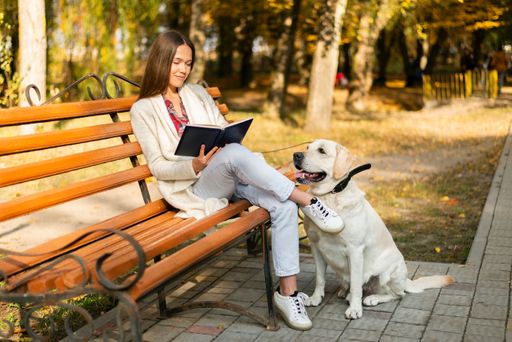Communication, social interaction, and behavior are all impacted by the complex developmental condition known as autism spectrum disorder (ASD). For those who have been diagnosed with it as well as their families, it is a lifetime challenge. Dogs, considered to be man's closest friend, are a fantastic ally. It has been demonstrated that these devoted and caring companions provide tremendous advantages to kids with autism.
Emotional Assistance and Company
Children with autism frequently have trouble interacting with others and connecting with their peers. Dogs, on the other hand, provide companionship and unconditional love. They don't pass judgment or offer criticism, and just being around them can make one feel safe and secure. The attachment to a dog can be powerful and therapeutic for children with autism who may struggle to build relationships with people.
Creating Space for Social Interaction
Social contact issues are one of the main difficulties faced by many autistic youngsters. They might have trouble conversing, maintaining eye contact, or recognizing social cues. Because of their unwavering affection and lack of judgment, dogs can offer wonderful friendship to autistic youngsters.
Dog Behavior
A therapy-dog interaction allows kids to practice important social skills in a fun and non-threatening setting. The presence of the dog frequently eases anxiety and boosts self-esteem, making it simpler for the child to interact with others. This increased self-assurance can eventually lead to more fruitful social relationships with friends, family, and therapists.
Increasing Interaction
Many autistic children struggle with verbal communication development. Others can have a restricted vocabulary or have trouble expressing their emotions and needs. Dogs can significantly contribute to the development of these kids' communication abilities.
Dogs and Children Communication
Children communicate their thoughts and feelings to therapy dogs through vocal and nonverbal cues when they interact with them. The dog may be spoken to, given commands, or communicated with through body language and gestures. Children may become more enthusiastic and competent communicators as a result of this connection. This improved communication with the dog can eventually translate into their interactions with people.
Giving Emotional Assistance
The ability to control one's emotions might be difficult for those with autism. Increased degrees of worry, annoyance, or sensory overload could be felt by them. In these situations, therapy dogs naturally possess the capacity to offer comfort and emotional support.
Control Emotions
Children with autism may be able to better control their emotions when a therapy dog is around. Oxytocin, a hormone linked to relaxation and bonding, can be released through petting or cuddling with a dog. It can help lower tension and anxiety. The tactile experience of caressing a dog's fur can be calming and reassuring for kids who suffer from sensory sensitivities.
Encouragement of Physical Activity
Regular physical activity helps children with autism often improve their motor abilities, coordination, and general health. Through play, walks, and other interaction activities, dogs naturally promote physical exercise. Doberman puppies are very good at physical activities, so they increase the activity of the child.
Children's Physical Activity
Children who participate in activities with a therapy dog may become more physically active. Playing fetch, taking a stroll or even just racing around the garden are all engaging and fun ways for kids to improve their motor skills and physical health. The kid's general health and energy levels may benefit from this physical activity as well. Physical activity eliminates the signs of autism.
Growing Independent
Routines and transitions are common struggles for autistic children. They could struggle with activities that call for independence, such as getting dressed, cleaning their teeth, or adhering to a regular regimen. The use of therapy dogs can be quite effective in encouraging self-reliance and self-care.
Sense of Responsibility
It promotes a feeling of responsibility and routine when kids are in charge of taking care of their therapy dog's basic requirements, such as feeding, grooming, and bringing them for walks. This may result in the youngster developing better self-care practices in daily life. The presence of a therapy dog can offer support and company, easing the difficulties that kids face regularly.
Bringing Down Sensory Overload
Many kids with autism have sensory issues which can make some noises, images, textures, or odors overpowering. Children who are experiencing sensory overload can benefit from the calm and gentle temperament of therapy dogs.
10 ways Dogs for Good helps individuals with autism
Road Safety
By using animal-aided intervention to promote road safety awareness and keep people with autism safer when they are out and about.
Joking Around
A child with autism can learn about sharing and taking turns by playing a simple game of pairs or hide and seek. A dog doesn't care who wins!
Defeating Fear
For someone with autism, having a trained dog around all the time provides a relaxing focus. Dogs for Good has assisted kids and adults with dental appointments, overcoming immunization phobias, and adjusting to school.
Fresh Possibilities
The introduction of a puppy can encourage a child to try something new. Life with a child with autism can be dominated by routines and limited interests.
Sensory Assistance
When a youngster is experiencing high levels of anxiety, the comforting weight of a dog's head lying in their lap can make them feel more at ease. It also provides excellent support for a child with special needs.
Building Relationships
Nothing surpasses an enthusiastic tail wave from a dog when human connections and relationships are challenging.
Conclusion
However, we discovered that dogs can affect confidence levels, help reduce anxiety, enhance communication, and help families accomplish more together. Autistic children experience fewer meltdowns in the presence of a pet dog, and their parents' stress levels are dramatically reduced. Self-harm is often a common reaction for a child with autism who is in a frustrating situation and cannot verbalize their frustrations. Even if the child is performing a repetitive, non-harmful action, the dog will often put itself between the child and the source of harm.



















